If you are an experienced gardener, seeing white spots on zucchini leaves in your garden may ring a warning bell in your mind. If you are a new gardener and don’t know what those flour dusted leaves mean- stay tuned! You need to explore powdery mildew treatments to save your squash, cucumber and rose plants!
I was working in my garden on a hot summer morning when I saw white patches on my zucchini squash plant. After sowing the seeds and seeing the plants grow quite beautifully, I panicked when I saw the warning signs that will affect my squash harvest. I’ve seen those flour dusted white leaves appeared on my squash, zucchini, cucumber, and roses before and have ruined the season for me. Thankfully, there are several inexpensive home remedies to treat the powdery mildew on plants in your garden.
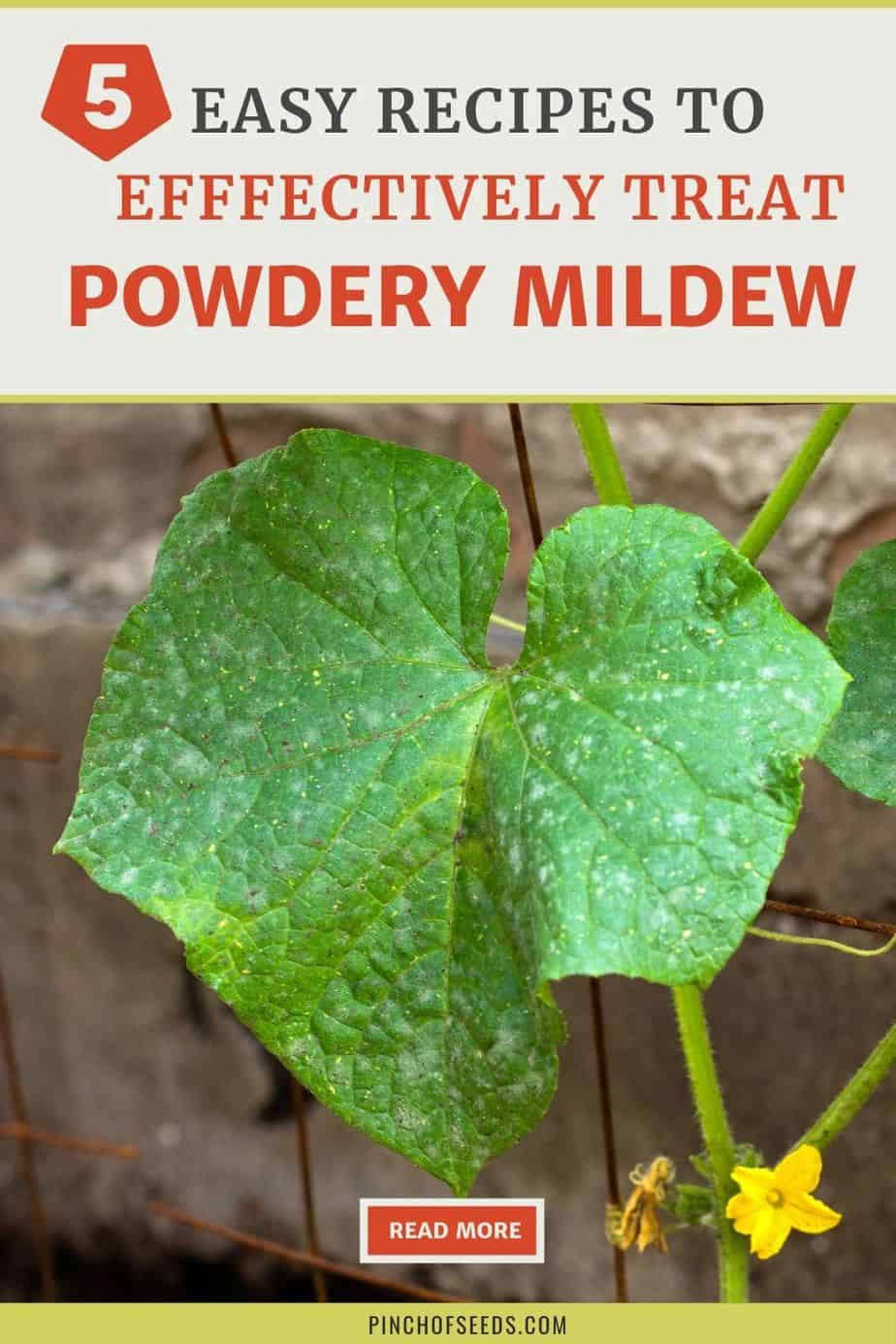
What is powdery mildew?
Powdery mildew is a fungal disease caused by a few closely related fungi. Each fungi targets a specific host plant for survival. The fungi produces a white, thread-like structure called ‘mycelium’ that grows on the surface of the host plant. This micro web structure is grayish white in color and looks similar to dusting of telcum powder. The fungus’s root-like tentacles penetrates the top later of the plant surface to suck the nutrients, but they do not damage the plant’s tissues.
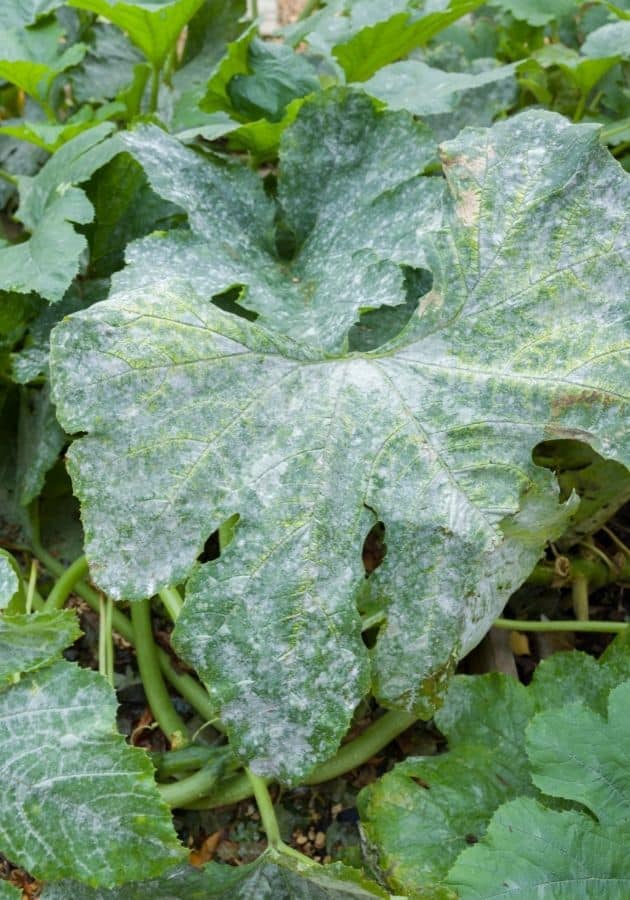
Powdery mildew is commonly found white mold on zucchini leaves. It also affects other squashes, vegetables, fruit trees, and garden plants. While most plants can be affected by powdery mildew, squash and cucumbers are more likely to host this fungus spores in your garden. The good thing is that powdery mildew seems to be relatively easy to control if you know what causes it and which environmental factors seem to encourage it to grow.
While this fungus is relatively easy to prevent, if left untreated, it can cause the leaves to curl and turn brown and potentially kill buds that produce squash. The fungus can also lead to loss of nutrients and may change the taste of the squash due to nutrient loss. Powdery mildew still needs to be remedied to ensure optimal squash yield. Addressing powdery mildew in a small garden space, container garden, or patio and working to prevent it in the first place without getting stressed is optimal.
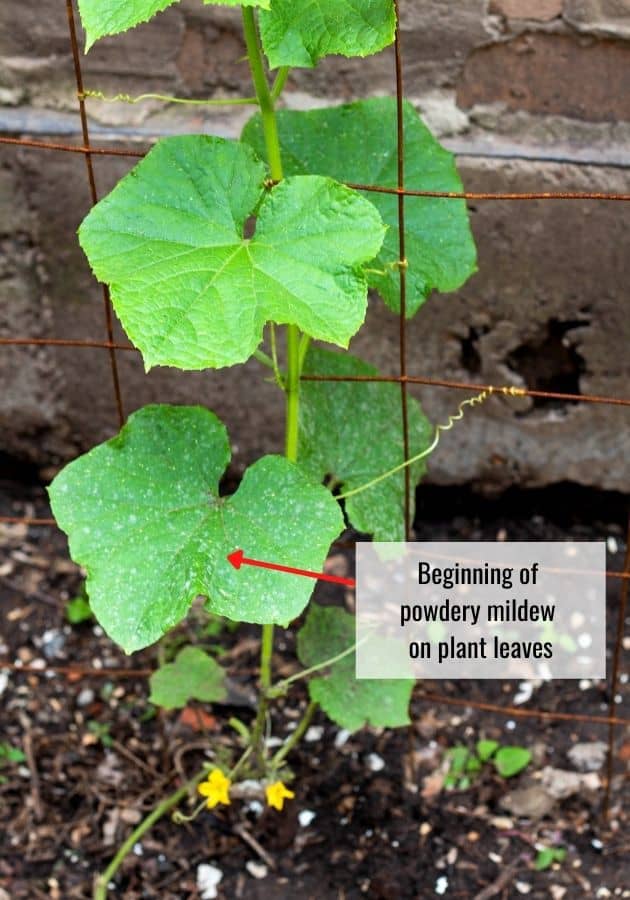
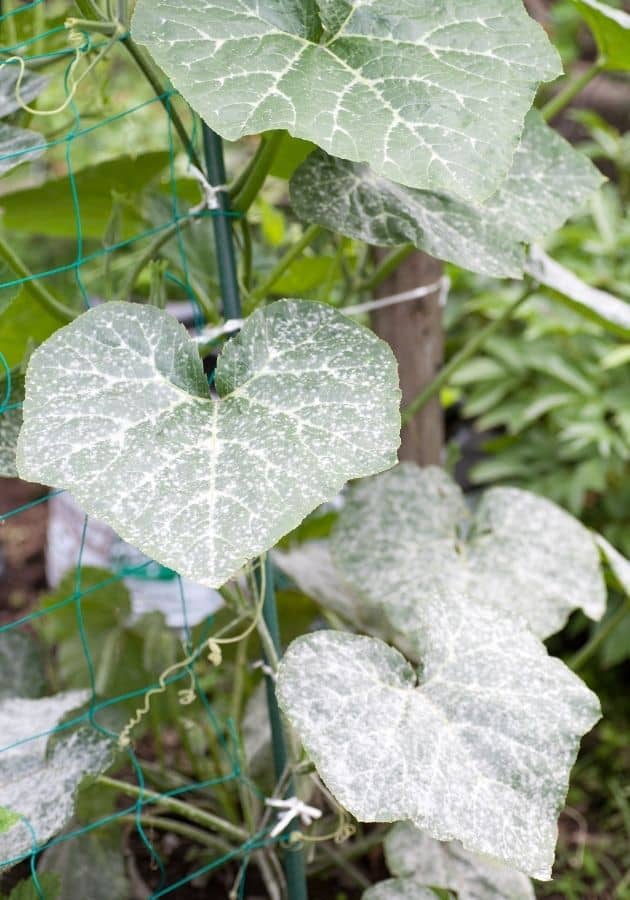
What causes the powdery mildew on plants
Many environmental factors combine to create a thriving situation for fostering the growth of the powdery mildew on plants in your garden.
Weather
Powdery mildew thrives when the leaves are dry, there is high humidity in the air, and the temperature is between 60F to 90F. When the days are hot and the nights are cooler, these conditions tend to help the fungus prosper. However, the spread of the powdery mildew slows down when the temperature rises above 90F during summer.
Lack of sunlight
The powdery mildew fungus also forms when there is not enough sunlight to provide at least six hours of light to the plant. Given the gardening conditions in smaller available spaces, it is often difficult to control the amount and direction of available light to your vegetables. Preventing powdery mildew from forming can be helped by providing enough direct sunlight to the squash plant’s leaves. If you are gardening in containers, it may be as simple as moving your plants to a full sun location. However, other preventative and treatment methods should benefit you if you are limited in location and light conditions.
Wind:
The spores of powdery mildew can travel quite far on a windy day. If a plant in your garden is infected by powdery mildew, it is very highly likely that other plants in your garden will get the spores through the wind. When the hosting plant’s environment is favorable, it will develop powdery mildew on the leaves.
Infected soil
The spores of the powdery mildew fungus can live in the soil for years. When the infected plant is not discarded promptly and properly, the spores stay in the ground, go dormant until the following year and come out when the weather conditions are favorable.
How to prevent powdery mildew on plants
Prevention is the best treatment when it comes to dealing with powdery mildew fungus. It is much easier to prevent powdery mildew with a few simple steps than treating it once it occurs on one of the plants in your garden. Squash, cucumber, tomatoes and roses are most likely to get affected by this fungus.
1. Plant Powdery mildew resistant varieties
The easiest proactive solution for preventing or controlling powdery mildew is buying or planting disease-resistant squash varieties.
Some plant varieties that have shown excellent resistance against powdery mildew are listed below:
2. Increase air circulation between the plants
Provide ample space between two plants for better air circulation. This will allow the additional moisture to evaporate and prevent the powdery mildew spores from germinating. It may be difficult for gardeners gardening in smaller spaces to provide enough airflow between plants, and adequate light conditions may be out of your control.
3. Discard infected leaves in the trash
You can get rid of powdery mildew by simply cutting off infected leaves and throwing them away. Throwing leaves away ensures that the fungus is not spread on the ground or in the compost bin. Even burning the leaves in a fire pit is discouraged as the spores can still be distributed through the air. Trimming the squash leaves is more of a spot treatment method and may not fix the problem long-term.
Additionally, you need to be careful of how many leaves you eliminate to avoid sunlight burning the squash as it develops and ripens.
4. Water at the base of the plant
The powdery mildew fungus starts growing in the soil and is moved on to the leaves. The fungus begins on the underside of the leaves. It moves on the front of the leaves as it progresses. Using a mulch, watering the soil versus the leaves, and checking the underside of leaves are ways to help prevent powdery mildew from spreading. If you can install drip irrigation, this is ideal for watering your squash and minimizing contact of spores from soil to leaves.
5. Do not over-fertilize
Another aspect that can help prevent powdery mildew in the first place is to not overfertilize. Frequently, pre-fertilized soils are more easily accessible when renewing your garden’s nutrients each year. In the case of container gardening or patio gardening, bagged soil like Miracle Grow is more readily available and contains quick-acting fertilizers. Overfertilization of fast-acting fertilizers can contribute to mildew problems. Instead, opt for garden soil labeled for vegetables and use a slow-release fertilizer which will also help reduce reapplying fertilizers throughout the growing season.
How to get rid of powdery mildew: 7 Treatments
Aside from pruning infected leaves, there are ways to prevent, control and treat powdery mildew. Your options are ready to use chemicals available in the garden store or mixing a few household ingredients to make a DIY powdery mildew spray. Most commercial fungicides help prevent or control fungus instead of fixing the problem when it occurs.
Suppose you are like me and you do not want to put harsh chemicals on your vegetables. In that case, you will need some alternative solutions to treat the powdery mildew. There are many ways to fix powdery mildew on plants. Thankfully, there are many solutions already found in your home. Popular ways to make powdery mildew treatment solutions include the use of baking soda, vinegar, neem oil, milk, and mouthwash.
1. Baking Soda Spray for powdery mildew
A better treatment solution for your squash plants is baking soda. Baking soda is an excellent option for treating powdery mildew. It is readily available in your home and will not cause any harm to the surrounding vegetable plants. With the baking soda method, you will also need some cooking oil and some dish soap. The cooking oil and dish soap ensure that the baking soda sticks to the leaves and does not easily wash off. You may still need to reapply after it rains. You should also be careful that the baking soda method does not burn your leaves.
Ingredients:
1 Gallon Warm water
1 tbsp Baking soda
1 tsp Dish soap or Castile Soap
1 tbsp Cooking Oil
Method:
- Fill a spray bottle with warm water. Add dish soap and shake the bottle for a few seconds.
- Add cooking oil and baking soda to the mixture. Shake the bottle to mix the ingredients well.
- Apply the spray on the top and bottom of the leaves affected by the powdery mildew.
2. Apple Cider Vinegar Spray for powdery mildew
Apple cider vinegar has a high enough acid content to help get rid of powdery mildew. The low pH level of the vinegar stops the growth and spread of the fungus in its tracks. Apple cider vinegar needs to be diluted with water so that the acid does not burn the plants. To be safe, you should test on a leaf before spraying it all over your squash plant leaves.
Ingredients:
1 Gallon Warm water
3 tbsp Apple cider vinegar
Method:
- Fill a spray bottle with warm water.
- Add Apple Cider Vinegar. Shake the bottle to mix the content.
- Apply the spray on the top and bottom of the leaves affected by the powdery mildew.
3. Neem Oil Spray for powdery mildew
Another organic option is using Neem oil spray for plants. Neem oil is a natural oil desired from the Neem tree. This is an excellent solution to treat powdery mildew as fast as twenty-four hours. One side benefit of Neem oil is it is harmful to insects that eat the plant’s leaves. So, this recipe works as a natural insecticide as well. There is some debate over whether Neem oil harms bees. Neem oil is not readily available in your home. Still, it is worth having around if you prefer organic ways to deal with diseases and pests.
Ingredients:
1 Gallon Warm water
1 tsp Dish soap or Castile Soap
2 tbsp Neem Oil
Method:
- Fill a spray bottle with warm water. Add dish soap and shake the bottle for a few seconds.
- Add neem oil to the mixture. Shake the bottle to mix the ingredients well.
- Apply the spray on the top and bottom of the leaves affected by the powdery mildew.
- TIP: This spray can be applied every 10 to 14 days throughout the season to prevent the powdery mildew from occurring.
4. Spray Milk for powdery mildew
Milk is another fantastic alternative that will not cause harm to any beneficial insects or hummingbirds. When milk has contact with the sun, it creates an effective solution to treating powdery mildew. Using milk requires a solution of milk and water. There are many variations of recipes out there for what milk to water ratio is needed for the spray. The best estimation is using four parts milk to six parts water to effectively stop the powdery mildew. There is no word on whether the fat content or percentage of the milk makes any difference in effectiveness. Although worth noting, sour milk will work just as well as drinkable milk. So do not throw away that rotten milk; use it to treat the powdery mildew in your garden.
Ingredients:
6 cups water
4 cups of milk
Method:
- Fill a spray bottle with warm water. Add milk and shake the bottle for a few seconds.
- Apply the spray on the top and bottom of the leaves affected by the powdery mildew.
- TIP: If you use sour or rotten milk, you may want to strain the milk before pouring it into the spray bottle to prevent the spray nozzle from clogging.
5. Mouthwash Spray for Powdery Mildew
Some gardeners have also similarly suggested the use of mouthwash. If mouthwash kills the bacteria in your mouth, it should surely kill fungus on your plants. Ensure that the mouthwash has ethanol (alcohol) to be truly effective in stopping fungus.
Ingredients:
3 cups water
1 cup Mouthwash with Ethanol
Method:
- Fill a spray bottle with water. Add mouthwash and shake the bottle for a few seconds.
- Apply the spray on the top and bottom of the leaves affected by the powdery mildew.
6. Wash with Water
While the use of water as a quick fix for small amounts of powdery mildew can also be used, it is not a recommended treatment. With powdery mildew growing on dry leaves and in high humidity, water is nothing more than a temporary fix. Water will wash away the spores of the mildew to prevent them from spreading but having wet leaves can lead to other issues for your vegetables. If you are going to use water to fix powdery mildew on the plant leaves, make sure that you do it in the morning, where the sun can dry the leaves before other issues can occur.
7. Commercial Sprays to treat Powdery Mildew
Here is a list of several ready to use treatments for powdery mildew on plants. Not all works the same. Read the instruction and follow them carefully to avoid any mishaps.
- Banish All Natural Fungicide
- Bonide Copper Fungicide
- BioAdvanced Insecticide Fungicide Miticide 3-in-1
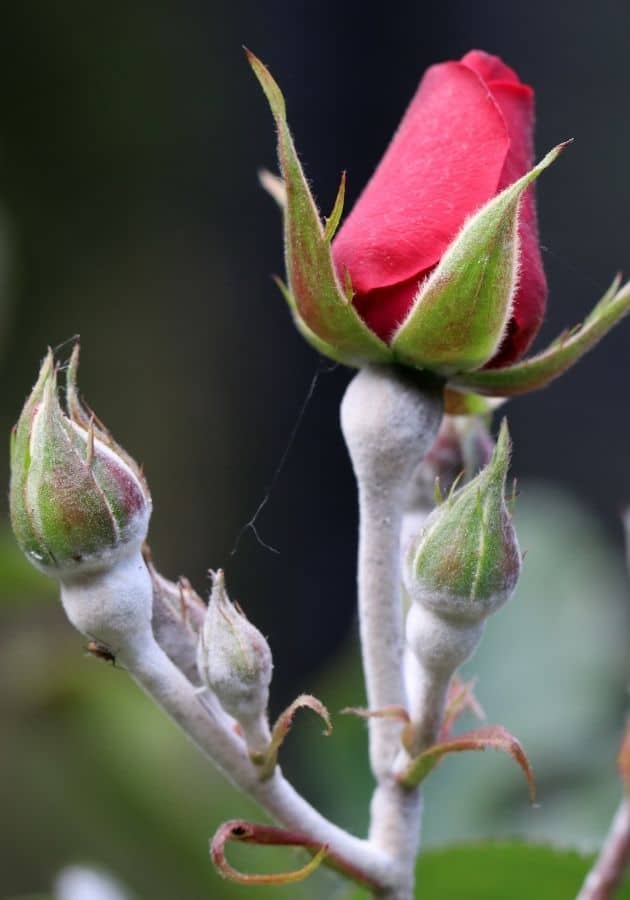
Other plants susceptible to powdery mildew
Powdery mildew can occur on many common plants in the garden. Tomatoes, pumpkins, cucumbers, roses, and zinnias have all been known to be susceptible to powdery mildew. Addressing the powdery mildew in your garden will help ensure that you do not see fungus spread to other plants. Again, the mildew spores start in the soil and spread to the underside of the leaves before you notice it. Remember that when days are hot and nights are cooler, you should be looking for the presence of powdery mildew on your plants. It is best to put a reminder in your gardening calendar. Keeping up with the prevention of fungus in your garden will ensure that any presence of powdery mildew does not spread. With squash, pumpkins, and cucumbers having large leaves, it is understandable that powdery mildew is much more common on these plants.
Be aware that there are many types of Zucchini mold on leaves. While white spots mean the presence of Powdery Mildew, the brown spots on squash leaves mean the plant is affected by ‘Downy Mildew’.
Conclusion
In conclusion, powdery mildew is a fungus that appears when the right conditions allow it to grow. Addressing the amount of light, fertilizer, air circulation, humidity, and pH levels can help prevent the powdery mildew from prospering. It is best to select seeds or plants that are disease resistant and are adapted to grow in your specific growing zone. Additionally, it is good practice to examine the underside of your squash leaves to spot fungus early and treat it early.
The options to treat powdery mildew once you notice it include baking soda, vinegar, neem oil, milk, and mouthwash. All of these treatment options listed require you to dilute them with water so that you do not risk burning your leaves. Treating powdery mildew when you first notice it can help prevent leaves from curling or browning. Treatment can also prevent buds from dropping and limiting the amount of squash you get out of your plant. With how significant and how much space a squash plant needs, yielding an adequate harvest will mean the time and effort you put in was worth it.
While there are other fungicides on the market. Chemical fungicides tend to target prevention and not solving an existing fungus issue. There may be climates where you cannot simply prevent powdery mildew, and you need to treat it as it occurs each year. In using other chemical methods, you also run into an issue where you could harm other plants or animals in the process. Organic, sustainable, and readily available options are the best methods for treating powdery mildew fast without any lasting adverse effects on your garden or your squash harvest.
In addressing powdery mildew on the plants, have you found other ways to help get rid of powdery mildew or fungus on your vegetables? Have you experienced powdery mildew on other garden plants? Share your experiences with others in the comments below. Perhaps someone has an interesting solution not covered in this post.

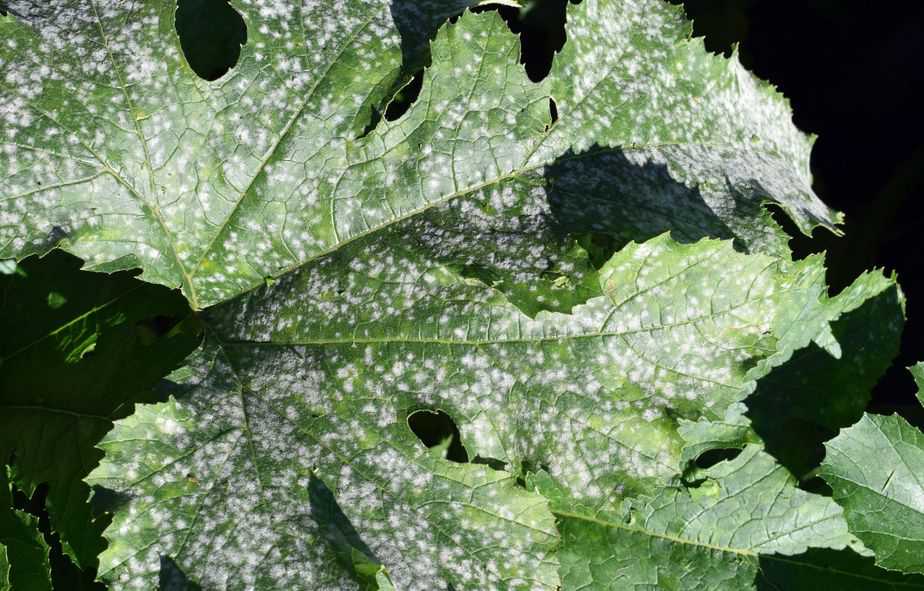
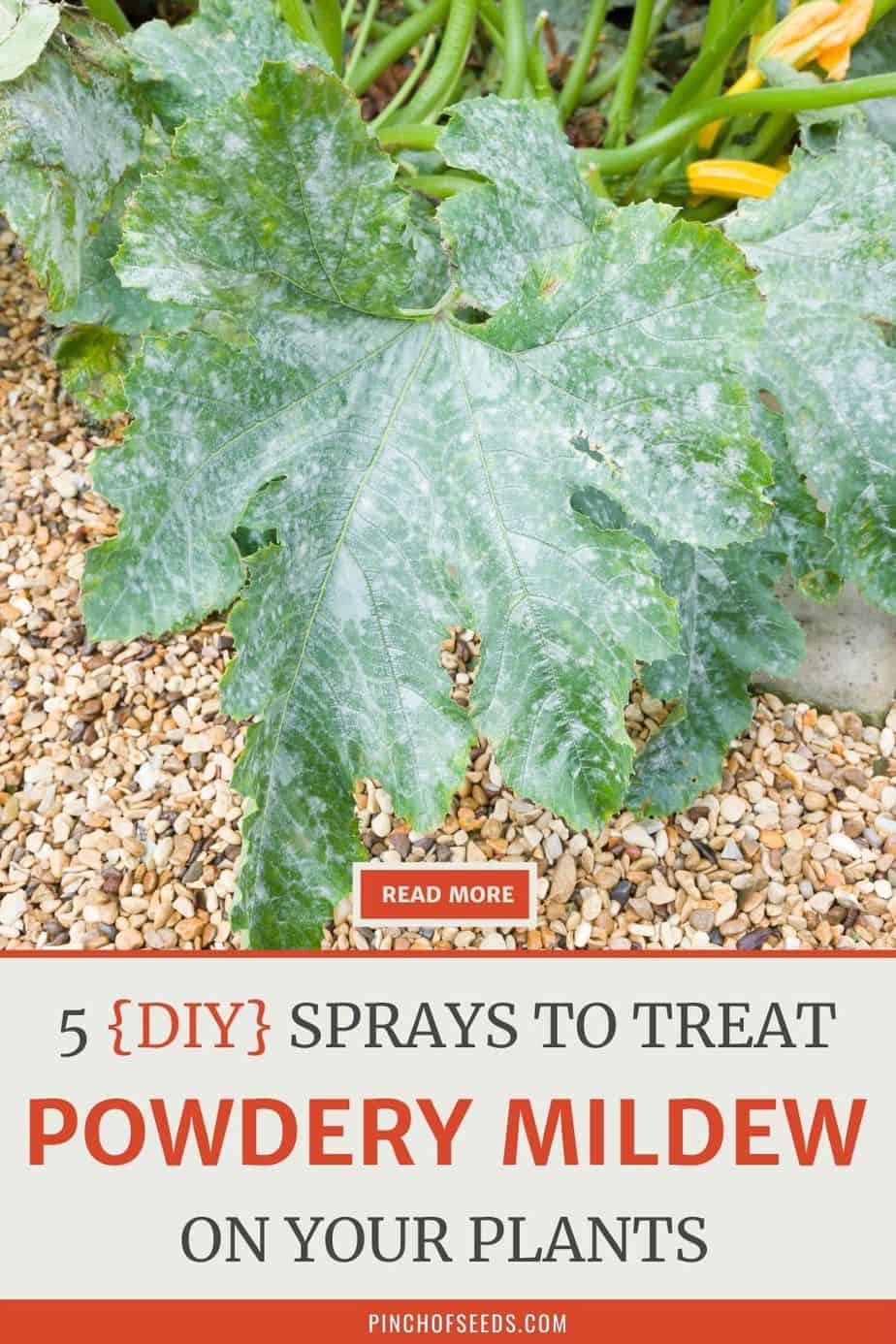
I have a big issue with it (mildew) along with squash bugs ! So as I picked eggs off my leaves I tried the ACV/water method. No rain for the next few days, so we shall see if it helps. Have the vegetable ding great, but should have read this article before now, as the mildew is more than a little. Will try to update to let any reader know how it worked.
Thank you so much for these fantastic remedies! I was wondering if I’m supposed to apply the Apple Cider Vinegar mix daily, or is it just once per season?
I am late on dealing with the mildew on my giant zucchini plants. It is mid October in central Oregon and the plants continue to produce well. I’m ready soon to toss them but how do I treat the soil so as not to affect next year’s plants?
Thanks!
You never said how often to use the baking sode spray on the zuchinni leaves,
Your article is on this gardening nightmare has come to my rescue! Now I finally know what I am doing wrong to help this problematic disease along after all these years!😩
That was excellent information, iam frustrated with my garden and limited space plus the weather can’t decide what season it’s on lol
But I will try the milk and see what happens. Thank you for your knowledge